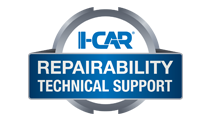OEM Restraints System Part Replacement Search
2014 Dodge Viper
Share:
|
DISABLE PROCEDURE AND TIME (Always Check Service Manual)
1. Disconnect and isolate the battery negative remote (ground) cable.2. Allow system capacitor to discharge for two minutes before removing airbag components.
REV : 03/2015
PARTS THAT MUST BE REPLACED FOLLOWING A DEPLOYMENT
Any vehicle which is to be returned to use following a Supplemental Restraint System (SRS) component deployment must have the deployed restraints replacedWith a driver airbag module deployment:
• Driver airbag [AIRBAG,STEERING WHEEL]
• Steering wheel
• Clockspring assembly
• Steering Column Assembly including Intermediate Shaft/Coupler
• Front Seat Belt Retractor Assemblies (Include Tensioners)
• All Seat Belt Buckles in use
• Front Impact Sensors
With a passenger airbag module deployment:
• Passenger airbag [AIRBAG,INSTRUMENT PNL]
• Instrument Panel top pad
• Passenger Airbag wiring harness or connector if available (Must use approved wire crimping tool and splices)
The seat belt tensioners are deployed by the same signal that deploys the driver and passenger airbags and must also be replaced if either front airbag has been deployed
PARTS THAT MUST BE INSPECTED AND REPLACED IF DAMAGED
It is also critical that the mounting surfaces and mounting brackets for the Occupant Restraint Controller (ORC) and front impact sensors be closely inspected and restored to their original conditions following any vehicle impact damage[MODULE,AIRBAG CONTROL; AIRBAG SENSOR,FRONT]
• Anchors and tether for children (LATCH)
• Inspect all trim panels
• All seat belts, buckles, etc should be closely inspected for cuts, tears, fraying or damage in any way following any frontal impact or airbag deployment. The seat belts are to be replaced when visible damage is incurred.
• All other vehicle components should be closely inspected following any SRS component deployment, but are to be replaced only as required by the extent of the visible damage incurred
There are two methods by which an airbag or seat belt tensioner may be connected to the vehicle electrical system.
1) The first method involves a short pigtail harness and connector insulator that are integral to the airbag or tensioner unit and are replaced as a unit with the service replacement airbag or seat belt tensioner unit.
2) The second method involves a wire harness takeout and connector insulator (squib circuits) that are connected directly to the air bag or tensioner initiator. The heat created by the initiator during an airbag or tensioner deployment will cause collateral damage to a directly connected wire harness take out and connector insulator. Therefore, these direct-connect type take outs and connector insulators must be repaired following an airbag or seat belt tensioner deployment.
| Additional Information |
*This matrix does not currently contain all production vehicles sold in the United States. The contents were developed in cooperation with AudaExplore, a Solera company. The contents are based on the information available at the time of publication. Updates and additions will be posted as they become available. To ensure that you are using the most recent information, always refer to vehicle maker technical information.









